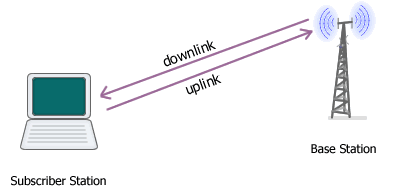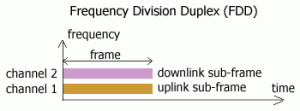Duplexing refers to the way downlink and uplink data is arranged in a two-way wireless transmission. The downlink carries information from a Base Station (BS) to Subscriber Stations (SSs, which could be a handset or a PC). Downlink is also known as forward link. The uplink carries information from a SS to a BS. It is also called reverse link. There are two types of duplexing schemes, FDD and TDD.

FDD (Frequency Division Duplex): It requires two distinct frequency channels for transmitting downlink sub-frame and uplink sub-frame at the same time slot (meaning simultaneously). FDD is suitable for bi-directional voice service since it occupies a symmetric downlink and uplink channel pair. Voice produces equal amount of data in both uplink and downlink directions constantly and hence referred to as symmetric service. FDD is commonly used in mobile networks (e.g. 2G and 3G). Meanwhile, WiMAX supports full-duplex FDD and half-duplex FDD (HFDD or HD-FDD). The difference is in full-duplex FDD a user device can transmit and receive simultaneously, while in half-duplex FDD a user device can only transmit or receive at any given moment.

FDD is inefficient for handling asymmetric data services (browsing, downloads) because traffic is generated in one direction (up or downlink) and other link remains reserved but unused, and data traffic may only occupy a small portion of a channel bandwidth at any given time.
TDD (Time Division Duplex) is another duplexing scheme that requires only one channel for transmitting downlink and uplink sub-frames at two distinct time slots (at different times). TDD therefore has higher spectral (radio frequency) efficiency than FDD. Here same single frequency is used to transmit & receive data in turns (doing only one thing at one time). Using TDD, downlink to uplink (DL/UL) ratio can be adjusted dynamically based on demand. TDD can flexibly handle both symmetric and asymmetric broadband traffic.

NOTE: 2G & 3G (GSM, UMTS, CDMA) make use of both FDD & TDD techniques simultaneously. First frequency is divided in channels using FDD and then each channels is subdivided time-wise into time lsots using TDD. These channels and time slots and paired together (hard coded), one for uplink & one for down link.
Most WiMAX implementations either on licensed or un-license frequency bands will most likely use TDD. The reasons are TDD uses half of FDD spectrum hence saving the bandwidth, TDD system is less complex and thus cheaper, and WiMAX traffic will be dominated by asymmetric data. The first release of Fixed WiMAX (802.16d) support both TDD and FDD, while Mobile WiMAX (802.16e) only includes TDD.
To read furteter on WiMAX please check this: WiFi & WiMAX
Nice info.
May i have a question please?
How many types of Duplex Techniques are there?
1) 1 2) 2 3) 3 4) 4
Thanks in advance.
Regards